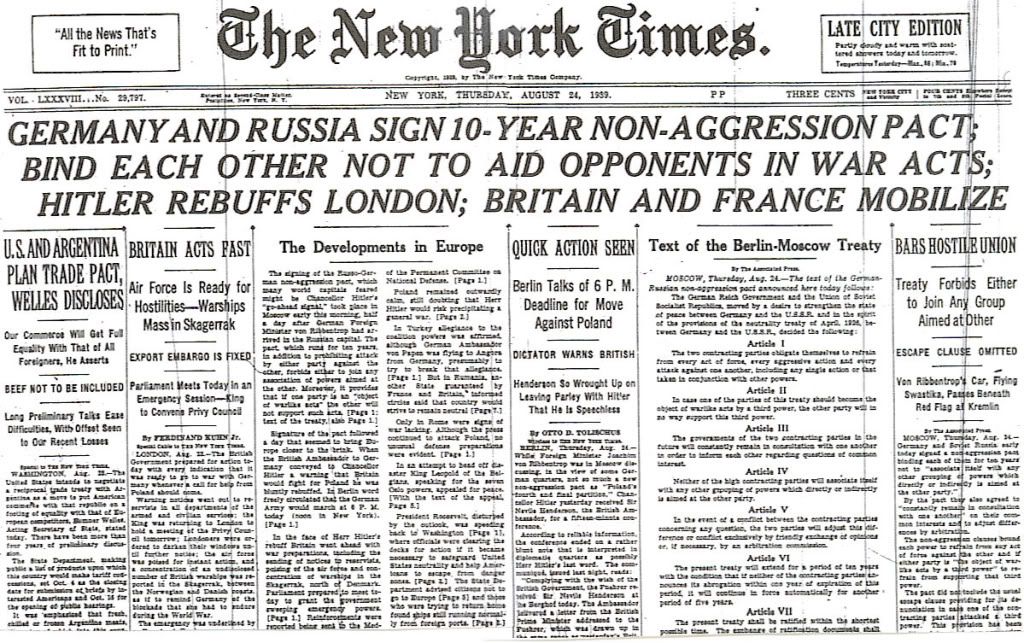
Posted on 08/24/2009 5:29:49 AM PDT by Homer_J_Simpson

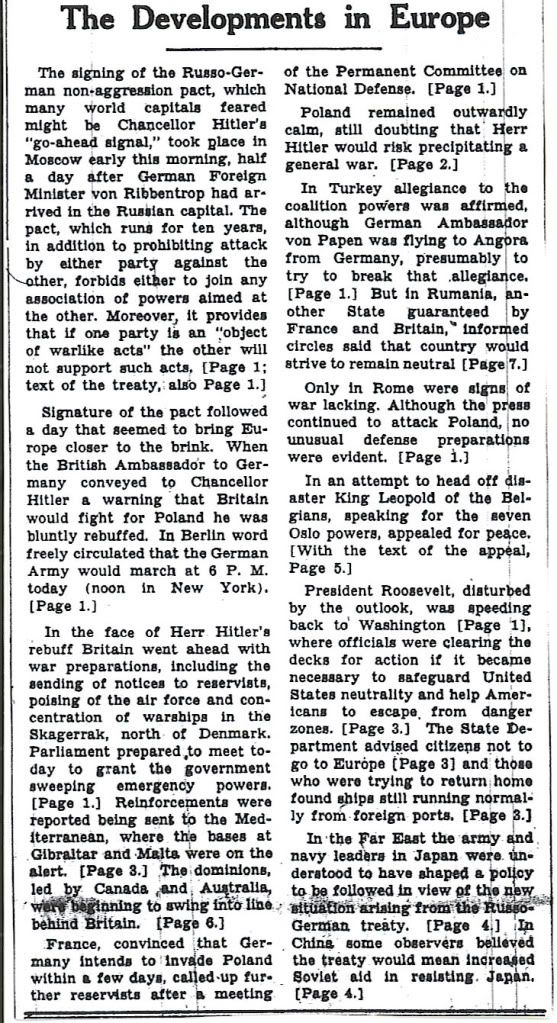
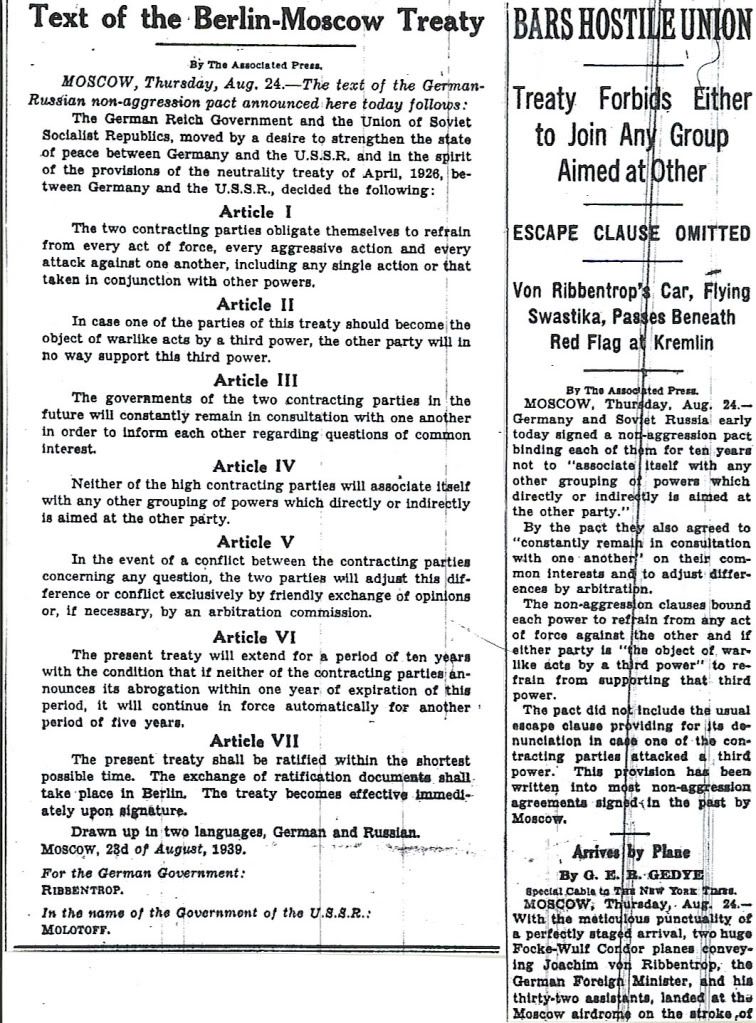

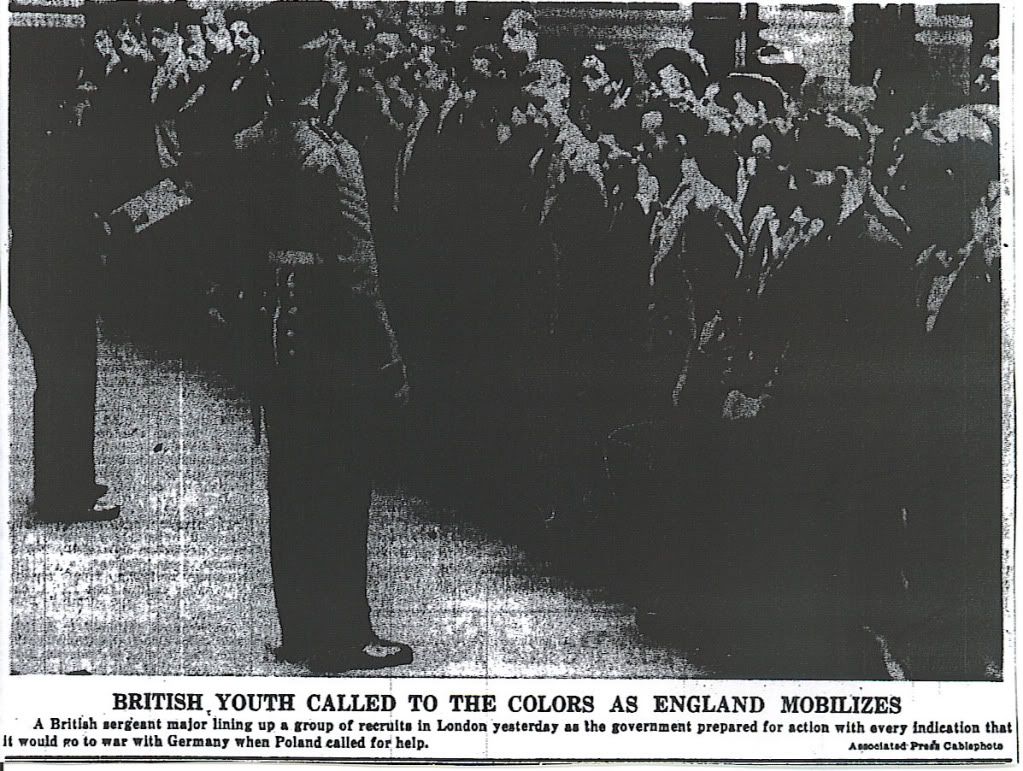
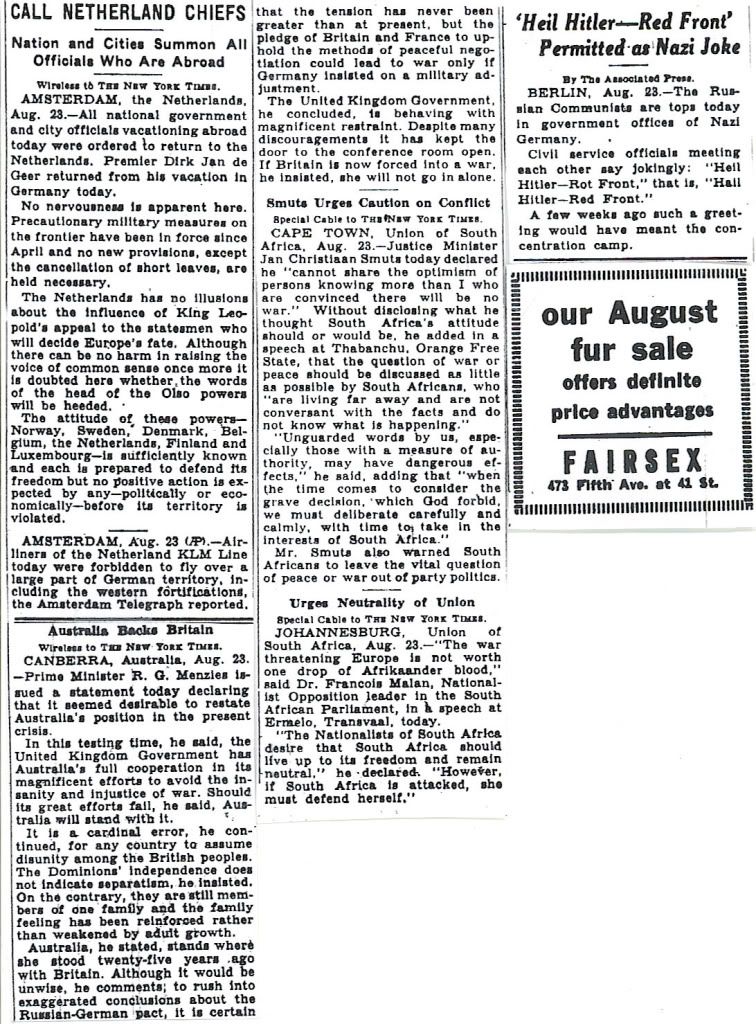
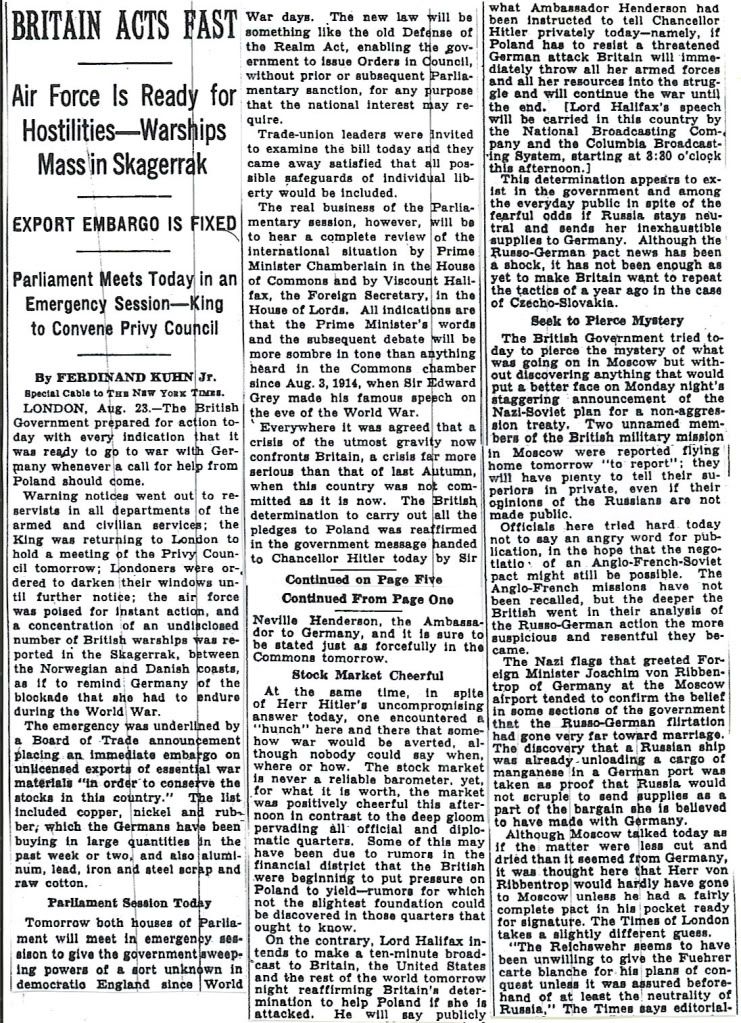

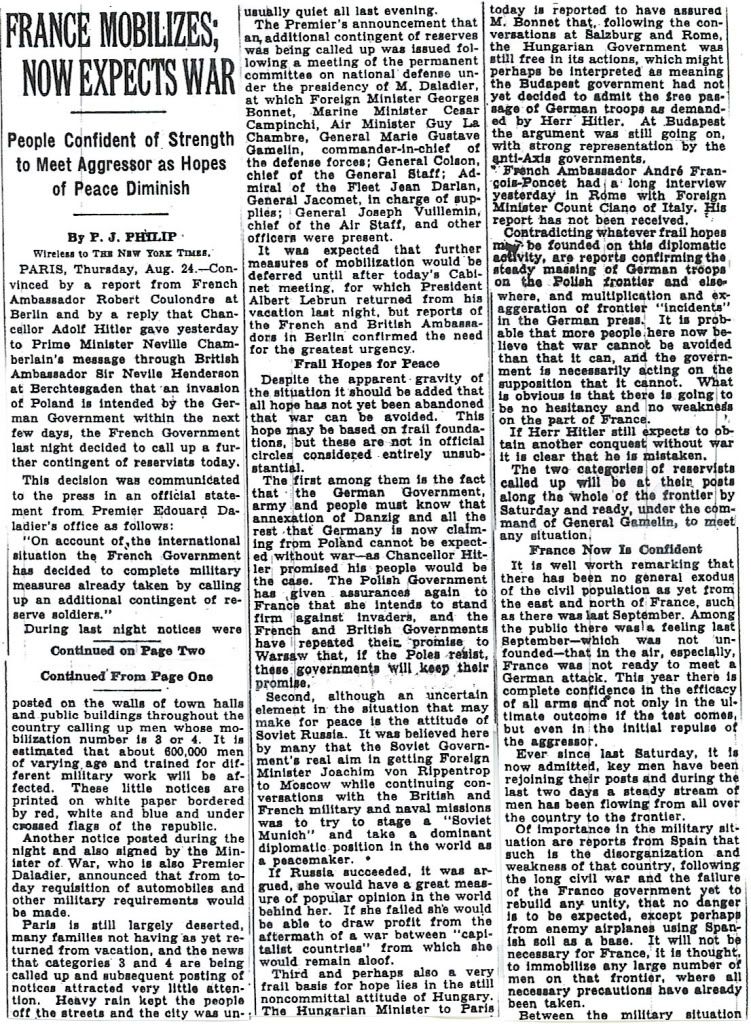
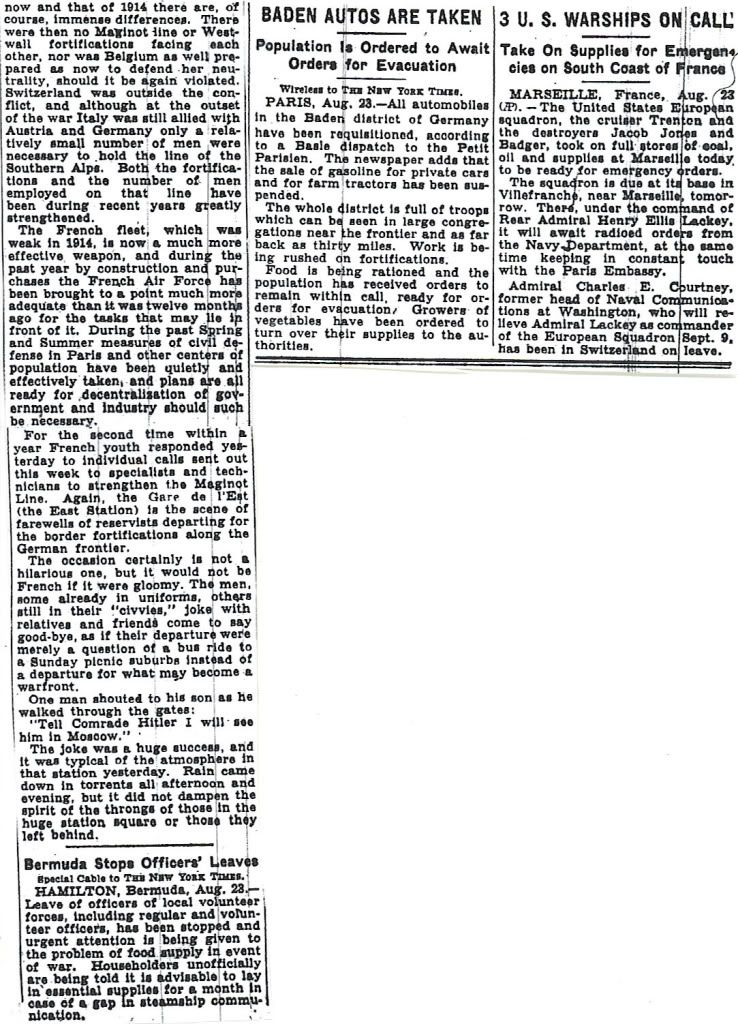
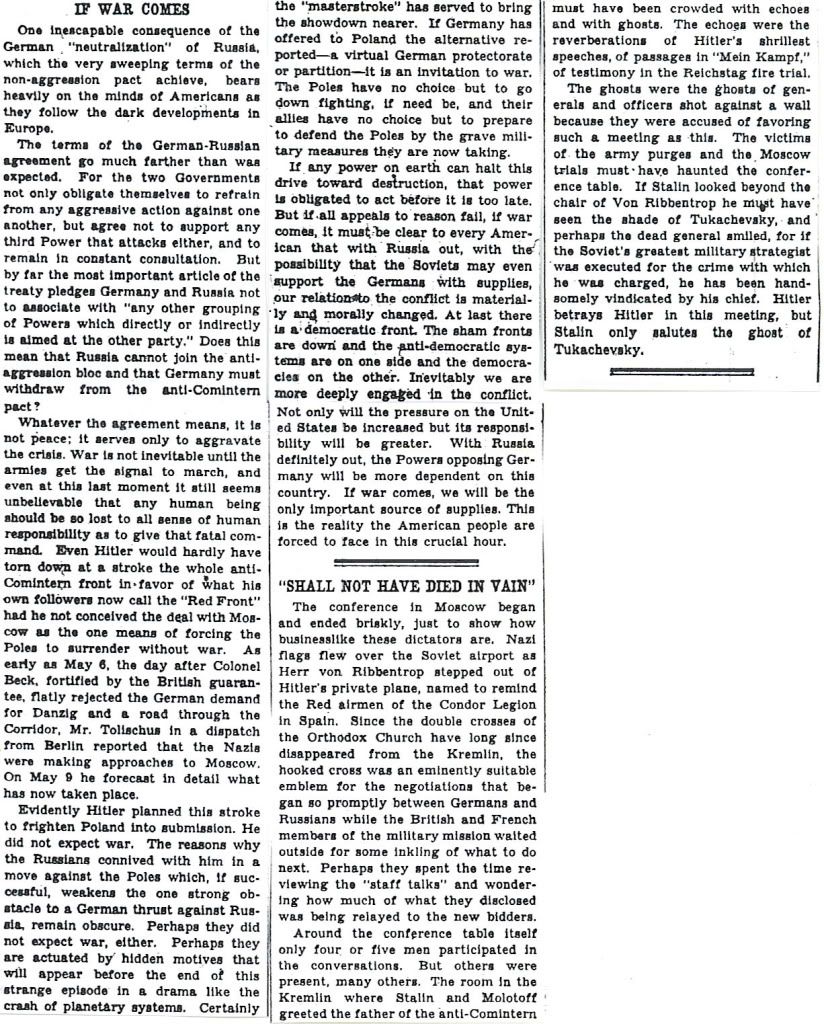
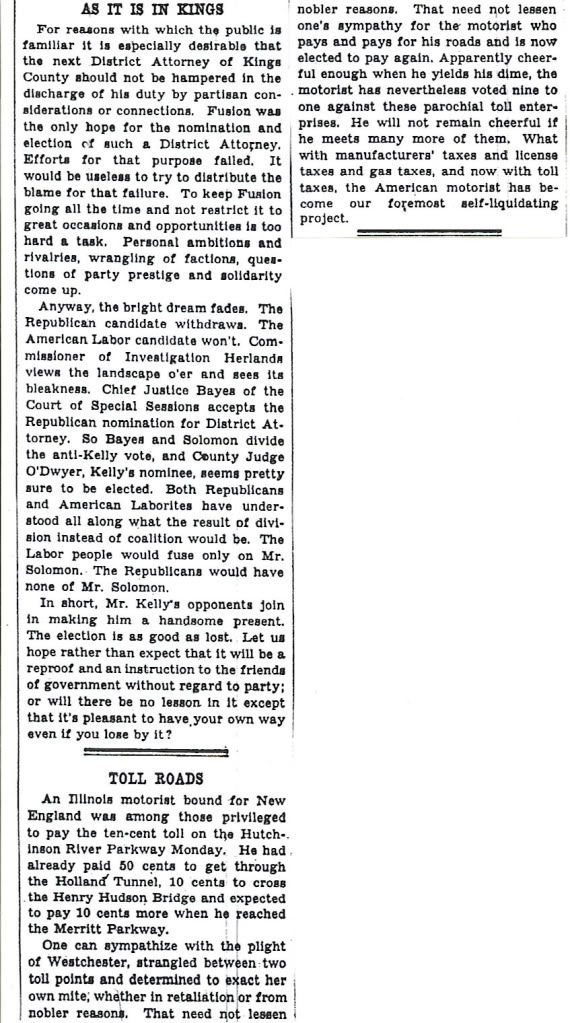
German special forces at this time were already operating in Poland.
For your list.
The Developments in Europe – 2
Text of the Berlin-Moscow Treaty – 3
Bars Hostile Union – 3-4
Call Netherland Chiefs – 6
Britain Acts Fast – 7-8
France Mobilizes; Now Expects War – 9-10
If War Comes (Editorials) – 11-12
Stalin actually trusted Hitler. He was shocked when Barbarosa started. Russian intel was really bad back then.
I reckon it is. As documented on this thread back in June.
Actually - their intel was OK, and they collected a lot of info regarding German plans (vide Richard Sorge’s reports)
The prolem is, that Stalin didn’t believe all the information they provided. He trusted his nazi friend so much.
Two points on the barrage of articles today.
1. King Leopold of Belgium and his pathetic pleas for peace. He still clings to the notion that Belgium can be “neutral” as it was for a century before 1914. He doesn’t realize the world has changed. He refused any cooperation with the allies before the war, or even during the coming “Phony War.” He stayed in Belgium to suffer with his people during the war, about the only noble thing he did in his miserable worthless reign. After the war his people overwhelmingly rejected him. What a fool.
2. The photo of the British lads being called to the colors. Many of them would not see home again for 6 or 7 years, if at all.
3. The NY Times editorial. I call it half right and half wrong. The half right is that America will have to take an increasingly active part in support of Britain and France whether the American public liked it or not. And from this point you start to see Congress passing legislation to gear up for war, the two most important being Selective Service and the Two Ocean Navy. Where the editorial is wrong is the belief that Hitler miscalculated in making his pact with Stalin, and that Stalin was the big winner thanks to a dead Marshall of the Soviet Union. The editorial states that Hitler thought this would get the Poles to surrender and avoid war. Wrong! Hitler wanted his war, right here and now. Stalin’s murder of Tukachevsky had nothing to do with the Germans. So what if Tukachevsky’s signed “confession” admitted that he was in league with the Germans? That document was found to have red stains on it, later confirmed to be the Marshal’s blood. I doubt it was signed voluntarily. No, Stalin’s murder of the Marshal and most of the rest of his officer corps was simply the logical extension of Stalin’s purges of the 1930’s. By 1939, there was very few individuals in the USSR who dared think of opposing Stalin on any issue (there were a very few, including the intelligence chief Proskurov, but he got purged later anyway).
Stalin drove a hard bargain, but Hitler gained by it. From this point forward, Hitler and Stalin are in a race to see who can be in the best position to break the pact and stab the other in the back. Hitler won that race.
Well, actually it was three points. I’m mathematically challenged.
Actually, the Russian intel was great. Read Murphy’s “What Stalin Knew.” I’m actually re-reading it right now. The Soviet intel agents in Europe penetrated very high into both British and German governments and military. The intelligence was from first-rate sources, mutually corroborating, and overwhelming. The problem was that Stalin refused to believe it, writing scatalogical notes in the margins of the reports. Of his three intel chiefs, Golikov, Fitin and Proskurov, only Proskurov dared to speak the truth and repeatedly warn Stalin. He was “purged” in late ‘41. Fitin, a civilian, knew what Stalin wanted to hear and not hear. He passed on info but kept his head down and didn’t press the issue. Golikov passed it on but his official “analysis” parroted Stalin’s line that the intelligence of pending German attack was all a “provocation” instigated by either rogue German officers or the British.
The intel failure was at the top in analysis, not content.
But you are very correct when you say Stalin trusted Hitler. That was Murphy’s conclusion as well; he said that in all his life Stalin only trusted one person, and that was the one person nobody should have trusted: Adolf Hitler.
S—t, meet fan!
Stalin never trusted Hitler. In fact he stated by agreeing to the partition of Poland he had “bought time” before he would have to go to war with Germany. The only real surprise to Stalin was that he was convinced that Hitler would not attack him until Britain had fallen rather than face a two front war. On that score he was incorrect.
The intel was fine. Churchill and Roosevelt both pased along warnings and intel. The ROTE CAPELLE sent detailed info on troop deployment and admin. planning for the conquered areas. Richard Sorge [from Tokyo] sent the exact date of the attack. A German deserter crossed the Bug on June 21st [PM] and told the Reds the attack was on for the next morning [Stalin ordered him shot]
The problem was Stalin refused to believe it, and the Politburo wasn’t about to risk its collective neck by disagreeing with him
On that I am not so sure. I think he deluded himself into believing in Hitler. It's what Socialist/Commies are good at. They believe their own BS.
I guess I should have been more specific. He never trusted that Hitler would live up to any non-agression treaty with the Soviet Union. I’m sure Stalin knew that it wasn’t a matter as to whether or not Hitler would attack Russia, but a matter of when.
Interesting that there was an alliance of most of the neutrals, the Oslo Powers, consisting of the Benelux countries and all of Scandinavia, lot of good it did them, since the Benelux countries, Denmark and Norway were occupied, Finland became a co-belligerant with Germany, after the Soviets seized Karelia, and Sweden was left as a neutral, slightly leaning towards Germany.
The second Trenton (CL-11) was laid down on 18 August 1920 at Philadelphia, Pa., by William Cramp & Sons; launched on 16 April 1923; sponsored by Miss Katherine E. Donnelly; and commissioned on 19 April 1924, Capt. Edward C. Kalbfus in command.
On 24 May, the light cruiser stood out of New York harbor for her shakedown cruise in the Mediterranean Sea. On 14 August, while in transit from Port Said, Egypt; to Aden, Arabia; Trenton was ordered to Bushire, Persia. She arrived on the 25th and took on board the remains of Vice Consul Robert Imbrie. She received and returned the gun salute to the late vice consul and departed the same day. Following stops at Suez and Port Said, Egypt; and at Villefranche, France; Trenton arrived at the Washington Navy Yard on 29 September.
In mid-October, while Trenton was conducting gunnery drills in the Norfolk area, powder bags in her forward turret exploded, killing or injuring every member of the gun crew. During the ensuing fire, Ens. Henry Clay Drexler and Boatswain's Mate, First Class, George Cholister attempted to dump powder charges into the immersion tank before they detonated but failed. Ens. Drexler was killed when the charge exploded, and Boatswain's Mate Cholister was overcome by fire and fumes before he could reach his objective. He died the following day. Both men were awarded the Medal of Honor, posthumously.
Later that month, Trenton steamed north to join in the futile search for a lost Norwegian ship. Following that mission, the light cruiser operated along the east coast until 3 February 1925, when she departed Philadelphia to join the rest of the Scouting Fleet off Guantanamo Bay, Cuba. After gunnery exercises, the fleet headed for the Panama Canal and transited it in mid-month. On the 23d, the combined forces of the Battle Fleet and Scouting Fleet departed Balboa and steamed north to San Diego. En route, the ships participated in a fleet problem, then assembled in the San Diego-San Francisco area. On 15 April, the United States Fleet put to sea for the Central Pacific and conducted another battle problem en route—this one designed to test fully the defenses of the Hawaiian Islands. After reaching Hawaiian waters, the Fleet as a whole conducted tactical exercises there until 7 June when most of the Scouting Fleet headed back toward the Atlantic.
Trenton—in Light Cruiser Division 2—sortied with the Battle Fleet on 1 July for a cruise to the South Pacific and visits to Australia and New Zealand. After stopping at Samoa, the ships visited the ports of Melbourne, Wellington, Sydney, Auckland, Dunedin, and Lyttleton. Late in August, Light Cruiser Division 2 turned homeward and steamed via the Marquesas and Galapagos Islands and the Panama Canal to rejoin the Scouting Fleet near Guantanamo Bay on 4 October. After gunnery practice, Trenton returned to Philadelphia on 9 November.
In January 1926, Trenton joined the other units of the Scouting Fleet and returned to Guantanamo for gunnery drills and tactical exercises. On 1 February, she departed Cuba with them, bound for Panama. During the next six weeks, she participated in combined maneuvers with units of both Battle Fleet and Scouting Fleet. In mid-March, the units of the Scouting Fleet returned to their home yards for repairs before leaving for summer training cruises with naval reservists and tactical exercises in the area around Narragansett Bay. In mid-September, she returned to Guantanamo Bay for winter maneuvers.
Trenton participated in maneuvers until just before Christmas when the units of the Scouting Fleet dispersed to their home ports for the holidays. Early in 1927, she joined the Scouting Fleet in combined maneuvers with the Battle Fleet near Guantanamo Bay. In May, Trenton was called upon to transport Col. Henry L. Stimson, a special observer in Nicaragua during a period of internal disorder. She embarked Col. and Mrs. Stimson at Corinto and carried them back to Hampton Roads. Following a review by President Cool-idge in June, the various units of the two fleets departed Hampton Roads for their normal summer routines. Light Cruiser Division 2, of which Trenton was flagship, operated off Narragansett Bay; then, in the fall, rejoined the Scouting Fleet for gunnery and tactical exercises along the east coast between Chesapeake Bay and Charleston, S.C.
In January 1928, Trenton and her division embarked marines at Charleston and returned to Nicaragua, where they landed to assist in supervising the elections which resulted from Col. Stimson's visit. 'She and her sister-ships rejoined the Scouting Fleet at Guantanamo and resumed maneuvers. On 9 March, Light Cruiser Division 2 parted company with the Scouting Fleet. The four light cruisers rendezvoused with the Battle Fleet off the California coast and headed for Hawaii, conducting drills en route. After exercises in the Hawaiian Islands, Trenton and Memphis (CL-13) cleared Honolulu to relieve Light Cruiser Division 3 on the Asiatic Station. During that tour of duty, she entertained Col. Henry L. Stimson, this time as Governor General of the Philippines. She participated in joint Army-Navy maneuvers in the Philippines and patrolled the northern Chinese coast, on one occasion putting a landing force ashore at Chefoo.
In May 1929, Trenton's division was detached from the Asiatic Fleet, and she steamed back to the United States along with Memphis and Milwaukee (CL-5). The light cruiser was overhauled at Philadelphia in the latter part of 1929 and then rejoined the Scouting Fleet. During the next four years, Trenton resumed the Scouting Fleet schedule of winter maneuvers in the Caribbean followed by summer exercises off the New England coast. Periodically, however, she was ordered to the Isthmian coast to bolster the Special Service Squadron during periods of extreme political unrest in one or more of the republics of Central America.
In the spring of 1933, Trenton moved to the Pacific and became flagship of the Battle Force cruisers. She operated in the eastern Pacific until September 1934. At that time, the ship returned to the Atlantic side of the Panama Canal to cruise with the Special Service Squadron. Over the next 15 months, Trenton visited ports in the Caribbean, in Central America, and South America as the squadron conducted a good-will cruise to Latin America. In January 1936, she retransited the canal and, after an overhaul at the Mare Island Navy Yard, rejoined the Battle Force until late in the spring of 1939. During that period, she made her second cruise to Australia in the winter of 1937 and 1938 for the sesquicentennial of the first colonization of that continent.
In May 1939, she returned to the Atlantic and, after a stop at Hampton Roads, got underway on 3 June for Europe. There she joined Squadron 40-T, a small American naval force which had been organized in 1936 to evacuate United States citizens from Spain and to protect American interests during the Spanish Civil War. Trenton patrolled the western Mediterranean and waters off the coast of the Iberian peninsula until mid-July 1940 when she returned to the United States. During her homeward voyage, the light cruiser carried Luxembourg's royal family then in flight from Nazi aggression.
In November, Trenton reentered the Pacific and rejoined the Battle Force, becoming an element of Cruiser Division 3. From 1941 to mid-1944, the ship served with the Southeast Pacific Force. At the time of America's entry into the war early in December of 1941, she was moored at Balboa in the Canal Zone. During the early part of 1942, Trenton escorted convoys to Bora Bora in the Society Islands where the Navy was constructing a fuel depot. From mid-1942 to mid-1944, she patrolled the western coast of South America between the Canal Zone and the Strait of Magellan.
On 18 July 1944, Trenton headed north for duty in waters surrounding the Aleutians. After stopping for a time at San Francisco, she arrived at Adak, Alaska, on 2 September. A month later, she shifted bases to Attu. In October, Trenton joined Richmond (CL-9) and nine destroyers in two sweeps of the northern Kuril Islands—one between the 16th and the 19th and the second between the 22d and the 29th—as a diversion during the invasion of Leyte. She returned to the Kurils again on 3 January 1945 to bombard enemy installations on Paramushiru Island, then resumed Alaskan patrols.
For the remainder of the war, Trenton patrolled the waters of Alaska and the Aleutian Islands and made periodic sweeps of the Kuril Islands. On 18 February, she returned to Paramushiru to pound shore installations. A (month later, she bombarded Matsuwa. On 10 June, the light cruiser shelled Matsuwa once more and made an antishipping sweep before conducting another bombardment during the evening hours of the llth. Between 23 and 25 June, Trenton, conducted her last offensive operation of the war, an antishipping sweep of the central Kurils. Task Force 94 split into two units. Trenton encountered no enemy shipping, but the other unit sank five ships of a small convoy.
Not long after that operation, the light cruiser steamed south for yard work. She reached San Francisco on 1 August, and the end of lihe war found her at Mare Island Navy Yard awaiting i.nactivation overhaul. Early in November, she headed south to Panama. Trenton transited the canal on the 18th, arrived at Philadelphia a week later, and was plact'.d out of commission there on 20 December 1945. Her nanne was struck from the Navy list on 21 January 1946'. On 29 December 1946, she was delivered to her purchaser, the Patapsco Scrap Co. of Bethlehem, Pa., for scrapping.
Trenton earned one battle star :for World War II

Trenton (CL-11) at Madeira during her service with Squadron 40-T, a Curtiss SOC Seagull floatplane on her catapult. The flag at the bow of her boat, in the foreground, shows that the U.S. Consul is on board.
The Badger was a World War I era destroyer that survived the war. The Jacob Jones was of similar vintage (both were Wickes class. It was sunk by a German sub with the loss of most of the crew.
Disclaimer: Opinions posted on Free Republic are those of the individual posters and do not necessarily represent the opinion of Free Republic or its management. All materials posted herein are protected by copyright law and the exemption for fair use of copyrighted works.